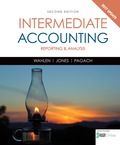
1.
Determine the accumulated amount in the savings account on December 31, 2021.
1.
Answer to Problem 11E
The accumulated amount in the savings account on December 31, 2021 is $64,041.28.
Explanation of Solution
Future Value: The future value is value of present amount compounded at an interest rate until a particular future date.
Person HD deposits $40,000 on January 1, 2016. Interest rate of 8% is compounded semiannually. Thus the interest rate per one half-year is 4%
Determine the future value as on January 1, 2016.
Hence, the amount of $40,000 deposited for 12 semi annum at 4% interest compounded semi-annually will have a future value of $64,041.28.
Note:
FV stands for Future value
PV stands for Present value
i stands for interest rate for each of the stated time periods
n stands for number of time periods
FV factor (Future value of $1: n = 12, i =4%) is taken from the table value (Table 1 at the end of the time value money module).
2.
Determine the accumulated amount in the fund on December 31, 2020, after the receipt of December 31 bonuses of 2020.
2.
Answer to Problem 11E
Accumulated amount in the fund on December 31, 2020, after the receipt of December 31 bonuses of 2020 is $31,764.24.
Explanation of Solution
Person BJ deposits the bonus amount of $5,000 each year in his savings accounts, starts from December 31, 2016. Deposit will earn 12% interest per annum. Number of time period from December 31, 2016 to December 31, 2020 is 5 years.
Determine the future value ordinary annuity.
Hence, the amount of $5,000 deposited each year for 5 years at 12% compound interest has a future value of $31,764.24.
Note:
FVO stands for future value ordinary annuity
i stands for interest rate for each of the stated time periods
n stands for number of time periods
fO stands for factor of annuity due
Future value of ordinary annuity of $1: n =5, i =12% is taken from the table value (Table 2 at the end of the time value money module).
3.
Determine the amount to be paid on January 1, 2019 by Person RS.
3.
Answer to Problem 11E
The amount to be paid on January 1, 2016 by Person RS is $11,566.29.
Explanation of Solution
Person RS owes $30,000 on a non- interest bearing note due January 1, 2026. On January 1, 2016 he offers to pay the amount after discounting the note at 10% compounded annually.
Determine the present value as on January 1, 2016.
Hence, Person RS would have to pay $11,566.29, on January 1, 2016.
Note:
FV stands for Future value
PV stands for Present value
i stands for interest rate for each of the stated time periods
n stands for number of time periods
PV factor (Present value of $1: n = 10, i =10%) is taken from the table value (Table 3 at the end of the time value money module).
4.
Determine the cost of annuity for Person JS.
4.
Answer to Problem 11E
The cost of annuity for Person JS is $50,303.06.
Explanation of Solution
Person JS will receive $6,000 each period on June 30 and December 31 for the next 6 years, from the annuity purchased on January 1, 2016. Interest rate is 12% per annum.
Number of time period from June 30, 2016 to December 31, 2022 is 12 semi annum.
Determine the present value ordinary annuity (Cost of annuity).
Hence, the cost of annuity is $50,303.06.
Note:
PVO stands for present value ordinary annuity
i stands for interest rate for each of the stated time periods
n stands for number of time periods
PO stands for factor of present value ordinary annuity
Present value of ordinary annuity of $1: n =12, i =6% is taken from the table value (Table 4 at the end of the time value money module).
5.
Determine the amount of equal annual contribution.
5.
Answer to Problem 11E
Amount of equal annual contribution would be $4,467.20.
Explanation of Solution
n – 5 annual cash flows
I – Interest rate 10% compounded annually
Future value – $30,000
First cash flow starts on December 31, 2016, and December 31, 2020 is the last cash flow. Here, the cash flow occurs during the first day of each time period, hence it is an annuity due.
Determine the future value annuity due.
Hence, the 5 equal annual contributions are $4,467.20.
Note:
Future ValueD stands for future value annuity due
Future value of ordinary annuity of $1: n = 6, i =10% is taken from the table value (Table 2 at the end of the time value money module).
There is no separate table provided in this module for future value of annuity due. Thus, factor of annuity due is calculated with the help of ordinary annuity table.
6.
Determine the amount of equal annual withdrawals.
6.
Answer to Problem 11E
Amount of equal annual withdrawals would be $2,525.68.
Explanation of Solution
n – 6 equal future annual withdrawals start from December 31, 2027.
I –Interest rate 10% compounded annually
Investment (Present value) – $11,000
Here, the cash flow occurs during the last day of each time period, hence it is an ordinary annuity.
Determine the present value ordinary annuity.
Hence, the 6 equal annual withdrawals would be $2,525.68.
Note:
Present value of ordinary annuity of $1: n = 6, i =10% is taken from the table value (Table 4 at the end of the time value money module).
Want to see more full solutions like this?
Chapter M Solutions
EBK INTERMEDIATE ACCOUNTING: REPORTING
- 4. A purchase of equipment for cash will:A. Increase assetsB. Decrease total assetsC. Have no effect on assetsD. Increase liabilitiesarrow_forwardWhen a company collects cash from a customer in advance, it should:A. Recognize revenue immediatelyB. Record a liabilityC. Record it as equityD. Ignore it until revenue is earnedarrow_forwardThe journal entry to record the purchase of office supplies on account would include:A. Debit Supplies, Credit CashB. Debit Supplies, Credit Accounts PayableC. Debit Cash, Credit SuppliesD. Debit Accounts Payable, Credit Suppliesarrow_forward
- 7. Which of the following is an adjusting entry?A. Payment of salariesB. Depreciation expenseC. Purchase of suppliesD. Payment of rent in advancearrow_forward5. What is the normal balance of the Dividends account?A. DebitB. CreditC. Zero balanceD. Depends on the type of dividendarrow_forward6. Which of the following transactions decreases stockholders' equity?A. Issuing sharesB. Paying dividendsC. Earning net incomeD. Receiving customer paymentsarrow_forward
- Accounting?arrow_forward9. If a company fails to adjust for accrued interest expense, what is the effect on the financial statements?A. Assets overstatedB. Liabilities understatedC. Revenues understatedD. Equity overstated need helllparrow_forward9. If a company fails to adjust for accrued interest expense, what is the effect on the financial statements?A. Assets overstatedB. Liabilities understatedC. Revenues understatedD. Equity overstatedarrow_forward
 Intermediate Accounting: Reporting And AnalysisAccountingISBN:9781337788281Author:James M. Wahlen, Jefferson P. Jones, Donald PagachPublisher:Cengage Learning
Intermediate Accounting: Reporting And AnalysisAccountingISBN:9781337788281Author:James M. Wahlen, Jefferson P. Jones, Donald PagachPublisher:Cengage Learning Excel Applications for Accounting PrinciplesAccountingISBN:9781111581565Author:Gaylord N. SmithPublisher:Cengage Learning
Excel Applications for Accounting PrinciplesAccountingISBN:9781111581565Author:Gaylord N. SmithPublisher:Cengage Learning



